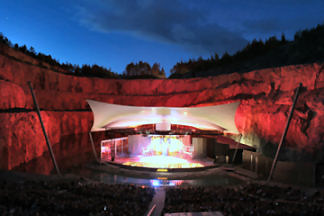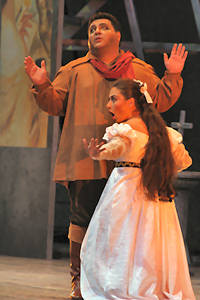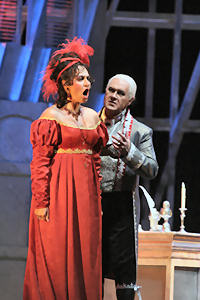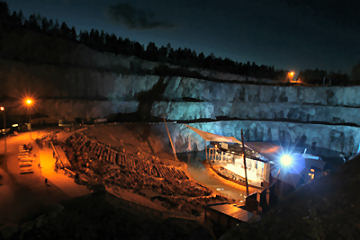Giacomo
PUCCINI: Tosca at Dalhalla, Sweden, 12 August, 2005 (GF)
Conductor and Artistic Director: Arvo Volmer
Director: Raimundas Banionis
Designer and Costumes: Sergejus Bocullo
Lighting: Neeme Jõe
Chorus Director: Elmo Tiisvald
Characters:
Floria Tosca: Oksana Dyka (soprano)
Mario Cavaradossi: Badri Maisuradze (tenor)
Baron Scarpia, Chief of Police: Sergei Leiferkus (baritone)
Cesare Angelotti, deposed Consul of Rome: Priit Volmer
(bass)
Sacristan: Villu Valdmaa (bass)
Spoletta: Urmas Poldma (tenor)
Sciarrone: Olare Vikholm (baritone)
Shepherd Boys: Victor Ivarson, Hannes Heinemann
Chorus of the Estonian National Opera, DalaSinfoniettan
and the Sinfonietta of the Värmlands Opera
Children’s Chorus/Linda Jansson

A week ago I reviewed
Turandot at Dalhalla (see review,
where I also wrote at some length about this fantastic arena)
and as the second instalment in this year’s opera festival comes
Tosca in the new production from the Estonian National Opera in Tallinn,
which was premiered in Tallinn on May 11th this year.
This was my third Tosca
within little more than half a year, but while the Stockholm
and Helsinki
were in the main traditionally realistic, the Tallinn version
is quite different. The stage design is sparse, minimalistic
even, with a backdrop in the shape of a metal construction,
a kind of distorted scaffolding (a society or a political system
gone astray?).
In the first act, playing in the Church of Sant’ Andrea
della Valle in Rome, Cavaradossi’s easel with the Madonna is
placed to the left in the foreground and further back there
are a number of oblong, painted screens, indicating church windows.
In the second act, in Scarpia’s office in the Palazzo Farnese,
the scaffolding is partly hidden behind a wall with several
doors and centre-stage is Scarpia’s desk. In the third act the
only prop is the gaoler’s little desk, where Cavaradossi later
writes his farewell letter to Tosca and sings E lucevan le stelle. There are some inventive lighting effects, the
most spectacular being the red light of dawn, projected on the
enormous, rough rock walls on both side of the stage. If the
staging aims at some kind of timelessness, the costumes are
decidedly true to the period, i.e. around 1800, the year when
the historical action takes place. Add to this the Brechtian
Verfremdungseffekt of having some of the
stage-lighting fully visible on stage and it seems obvious that
the director wants to say that this, to be sure, happens to
people in the year 1800 in Rome but it could happen – and does
happen – anywhere and anytime. The audience’s interest should
focus on the people and the action, not on the setting. The
intention is good, but does it work?

I’m afraid it isn’t wholly successful,
principally because the main characters seem to be distanced
from each other. It is quite a static performance; the actors
are, even where they should be close, mentally or physically
isolated. Sometimes it verges on absurdism with characters turning
their back to the one they are addressing. The acting isn’t
very convincing either, rather stiff, rather formal and rather
old-fashionedly theatrical. Whether this is due to (lack of)
instruction or lack of acting ability is hard to know. There
is one brilliant exception, to which I will come back: Sergei
Leiferkus’ Scarpia. Some of the action is also almost parodic:
the supposedly weak and exhausted Angelotti, recently escaped
from long-term imprisonment, runs and climbs like an athlete,
Spoletta, the police spy, who should be oily and menacing, also
scampers about like a rabbit and even the firing squad in the
last act march in and out as if they were in an operetta.

If this may sound unredeemingly
harsh, there are other, more successful features - the costumes,
for one. Scarpia and his henchmen are dressed in formal black
and white, matching the aluminium-grey sets, but the lining
of Scarpia’s long coat is red – red as blood. Tosca is in the
first act dressed in virginal white but carrying a bunch of
red roses – red as blood. In the second act she is dressed all
in red – red as blood! The second act Scarpia – Tosca scene,
the peripeteia of the opera if you like, is also interesting.
After Tosca has consented to Scarpia’s offer – if she becomes
his, Cavaradossi’s life will be spared – Scarpia goes to one
of the doors at the back of the stage to get pen and paper and
Tosca strengthens herself by hastily knocking back two glasses
of wine at his table; she finds his knife, she raises it and
her first intention is to take her own life. That was my interpretation,
but my wife, who has had some medical training and obviously
has a more murderous inclination, said that she was only testing
how to make the incision. Be that as it may, but after the completed
murder – Scarpia lying on his own desk, where he has decided
upon so many murders – his corpse is illuminated in red – red
as blood! And then Tosca does what she should do, according
to the original intentions of Sardou and the librettists: she
places the two candle-sticks, which conveniently enough are
already on the desk, on either side of his body and then takes
off the chain around her neck, which presumably has a cross
on it, and puts it on Scarpia’s chest. This symbolism is, I
think, essential to the story. The director Raimundas Banionis
discusses this in the programme booklet. “Has Tosca a right
to kill? Has a human being the right to take somebody else’s
life, even if this life is disgusting and abominable? Having
gone through this trial, Tosca as a true Christian exclaims
– NO. You have not created life and you have not been given
the right to extinguish life. Blood can never be washed off
your hands – blood will always pursue you. At first sight Tosca’s
last words should perhaps have been intended for her lover,
Cavaradossi. But no –
O Scarpia, avanti a Dio! – O Scarpia, we’ll meet before
God! – God is our judge before whom we are all equal. It is
to Him that Tosca’s and the opera’s last words are directed.”

No two productions of the same
opera tells exactly the same story, there are innumerable ways
of reading and interpreting the text. Differences are not necessarily
differences in quality and I may well have missed some point
in Raimundas Banionis’ reading, but one point I definitely did
not miss was the quality
of the singing: it was world-class!
The Estonian National Opera’s chief
conductor Arvo Volmer – who also has the same position with
the Adelaide Symphony Orchestra – lead a well-rehearsed performance,
free from the over-the-top bombasms that are tempting in this
“shabby little shocker” as it has been called. Instead he highlighted,
just as Badea did in Stockholm, the many orchestral felicities
and the lyrical qualities of this score. He had not brought
his own orchestra from Tallinn but was well served by the amalgamated
DalaSinfoniettan and the Värmlandsoperan’s Sinfonietta. The
Estonian chorus gave us a mighty Te Deum at the end of Act I
and the children in the same act were lively, as was the Sacristan
Villu Valdmaa, younger-looking and younger-sounding than most
Sacristans, but none the worse for that. The other comprimario
parts were mostly well taken by regulars of the Estonian company
but the world-class label applies to the three main characters.
Sergei Leiferkus, for many years
a leading, maybe the leading Iago and Scarpia, is rather
small of stature, but he dominates the stage whenever he appears
through his bearing, his restrained but well-calculated acting,
his facial expressions (difficult to discern at Dalhalla, due
to the distance between stage and audience – I was seated on
row 16, which is fairly close but since we have that lake, even
the front rows are bit off-side; anyway through my binoculars
I was able to watch him in some crucial situations). His voice,
not beautiful in the traditional sense of the word, but truly
expressive, is in itself evil-sounding and he articulates every
syllable admirably, spitting out his words with venom. His voice
reminds me of Boris Christoff’s, another great singing actor.
If there is a weakness it is that he is so obviously an evil
person. Tito Gobbi and Giuseppe Taddei, two great Scarpias from
an earlier generation, could appear even more dangerous by being
honeyed, seductive, but Leiferkus’ Scarpia is obviously so self-assured,
trusting his charisma – and possibly his position – that he
doesn’t need more sophisticated means. His interpretation is
closer to George London’s, a third Scarpia on disc that I have
admired through the years. Anyway, Leiferkus’ assumption of
the role will not be easily forgotten.

Badri Maisuradze, whose Don
Carlos in Stockholm I admired earlier this year,
was a splendid Cavaradossi, not a tremendously inspiring actor
but his singing was everything one could wish for. His Recondita armonia in the first act was splendid, powerful but sensitive
and in the following long duet with Tosca both singers found
much more nuances than most singers do. His outbursts in the
second act, which he mostly spent in the torture chamber, were
heroic but it was in the last act that he really showed off
– not principally through gleaming high notes, which also were
there, but through an identification and sensitivity that is
rarely heard in this role. E
lucevan le stelle (And the stars were shining) was given
a well-judged reading, and so far during the performance it
was dark enough for some stars to appear in the sky, and then
in the last duet his singing of O
dolce mani surpassed everything I can remember hearing,
live and on records, since Tagliavini in the 1950s – so exquisitely
nuanced, such marvellous pianissimos!
And Tosca herself, the young Ukrainian
soprano Oksana Dyka, is nothing less than sensational. Her voice
is a true lirico-spinto, absolutely even throughout the range,
warm and beautiful and at dramatic high-points she can add some
steel to the notes as well. It is a Tebaldi-voice, and that
is high praise indeed. She finished her training at the conservatory
in Kiev as recently as 2004, although she has been singing at
the National Opera there since 2001, and judging from this performance
she seems destined to have a great career in the future. And
it is not just a glorious voice that rings out magnificently
to fill even the largest hall; she can also sing an inward,
hushed pianissimo that sends shivers down the spine, even on
a jaded opera freak. After the dramatic outbursts in the second
act confrontations with Scarpia, she sang a perfectly vocalized
Vissi d’arte that
made time stand still. One could actually have heard the proverbial
pin drop. In this aria she also adopted a lighter, more frail,
more vulnerable tone, reminding us that in the rest of the opera
she is to a greater or less extent the actress Tosca, but this
prayer is her private appeal to the Creator. With further routine
and polishing her acting a bit more she might well go to the
top of the trade.
There were long and tremendous
ovations after this aria and after the performance, which of
course ended with Tosca hurling herself from the castle of Sant’Angelo,
but not out of sight from the audience; instead she remained
fully visible, hanging in mid-air like a red bird in a frozen
last picture from a film sequence. A spectacular end indeed.
The Dalhalla surtitles, cleverly
placed as subtitles just above the surface of the lake surrounding
the stage, are of course helpful to the many visitors who are
not regular opera-goers, provided they understand Swedish, but
since marketing is to a great extent directed to an international
audience, it would be a good idea to have also English translations.
The Finnish National Opera is again a good example.
Next year’s opera festival will
include Il trovatore in a new production from Tbilisi
National Opera in Georgia, and Carmen
in a production from Opera Iceland – Kristiansand, Norway, directed
by Jonathan Miller, no less. Something to look forward to!
Göran Forsling
Photographs © Martin Litens







